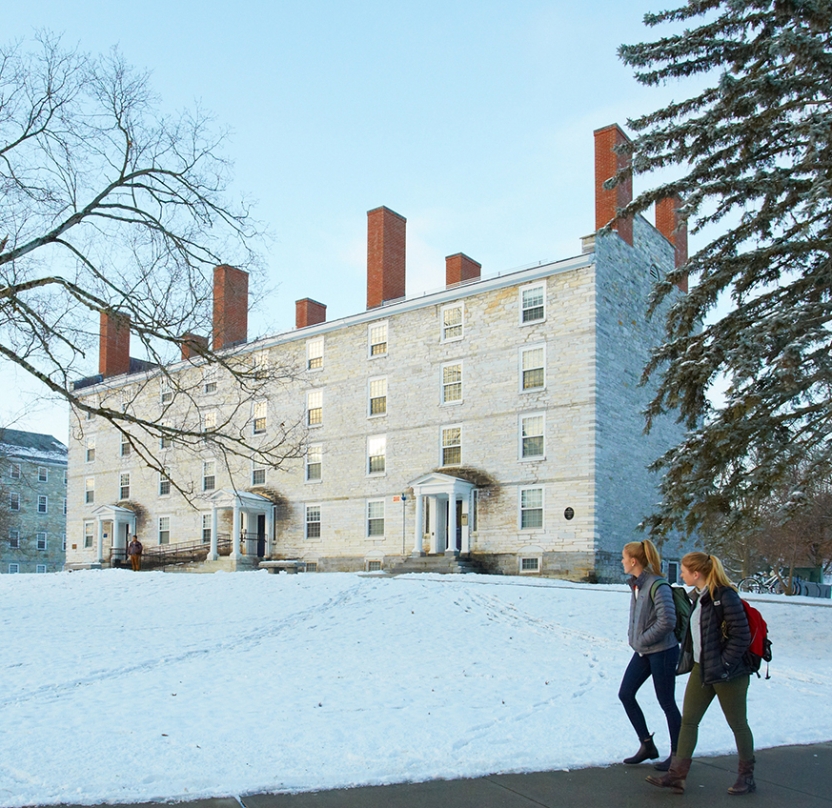Painter Hall Turns 200

Slide Show
[view:embed_content==543670]
MIDDLEBURY, Vt. – With little fanfare, Painter Hall turned 200 years old this fall. Named for Gamaliel Painter, one of the pioneer settlers of Middlebury in the 1780s, a founder of the College, and a man whose cane remains a symbol of the institution to this day, Painter Hall has played a unique role over the past two centuries.
By 1810, ten years after its founding, Middlebury College was in need of additional space. It had been housed in an imposing but drafty wood-frame structure known as the Academy Building, near the present-day site of Twilight Hall, which it shared with the local grammar school.
Gamaliel Painter and fellow civic boosters raised some $9,000 plus a hefty amount of building materials donated by the townspeople of Middlebury. Seth Storrs donated land from his hillside sheep pasture for the site, and Painter, 67 at the time, took charge over its construction. Ground prepared and foundation laid in 1810, the hall would be built of limestone quarried nearby in Weybridge and hauled up the gentle hill by yoked teams of oxen. Its design was “practical and straightforward,” noted Professor Emeritus and architectural historian Glenn Andres in his work “A Walking History of Middlebury.”
The contractor was William Baker, whose previous work included building the first Capitol dome in Washington, D.C. That building was burned by invading British soldiers in 1814 during the War of 1812.
Initially called “West College,” a nod to the downhill Academy Building now named “East College,” it would be 106 feet by 40 feet, four stories tall with three east-facing entrances leading to separate staircases, its rooms outfitted with fireplaces. Eight tall brick chimneys bristled from the roof. The project was a welcome one for many town citizens who gained jobs as laborers, ox-wranglers, masons, carpenters, and plasterers. Local retailers, blacksmiths, millwrights, and manufacturers benefited as well.
Construction took six years, but when it was completed in early 1816, partially occupied that spring and fully so in the fall, the magisterial stone structure would set a tone and inspire architectural echoes across the campus that would spread across the pastures and fields of the campus to this day.
A year later, West College was the site of a tragedy keenly felt on campus and in town. It involved Solomon Metcalf Allen, 28, of Pittsfield, Massachusetts, a Middlebury graduate, Class of 1813 with honor in philosophy, who had just been appointed by trustees as professor of Greek and Latin after two years as senior tutor at Middlebury. On September 23, 1817, Allen ascended to the roof to make repairs to a smoking chimney, as he had twice done before. This time, however, he did not carry the rope he had used for safety. When his improvised scaffolding broke, Allen fell 10 feet to the roof surface, slid down the roof and fell four stories to the ground. He died the next day.
West College was renamed Painter Hall after the death in 1818 of Gamaliel Painter (who bequeathed nearly all of his large estate to the College), and the building would see many purposes before becoming, in the 1930s, one devoted exclusively to student housing. In its earliest days, when most students boarded with families in town, Painter Hall contained classrooms, a lecture room, and offices. A two-story library with stacks and study rooms occupied the north part of the building until well after Old Chapel, as it is known today and which later became home to the library, was erected in 1836.
In 1877, Painter Hall became the site of the College’s first gymnasium, which occupied two stories of Painter Hall’s south side, nearest Old Chapel. The space was equipped with cable-pulling strength machines, parallel bars, vaulting horses, rings, dumbbells, medicine balls, and Indian clubs. As late as 1898, the multipurpose building contained classrooms, student rooms, and the only lavatories on campus.
Painter Hall emerged in its current use and form in 1936, following a complete interior renovation. (That was the same ambitious year that Middlebury constructed Forest Hall.) Photographs from 1936 portray a complete void inside: bare stone walls, empty window sockets streaming pale light, eight brick chimneys soaring four stories, their fireplaces hanging in the air, massive beams and the roof overhead.
Students living in Painter Hall today — all upperclassmen — enjoy a central spot on campus, with easy access to classroom buildings, McCullough Student Center, and the Davis Family Library. And while the two-century-old building may lack some of the modern amenities of the Atwater suites or the new Ridgeline townhouses, Painter offers other perks, says Cameron Pierce, a senior living in the building. “A nice view, a relatively large, relaxing space, good neighbors — I can’t complain.”
Painter Hall is the oldest college building in Vermont and, in 1990, was placed on the National Park Service’s National Register of Historic Places. Visit Middlebury History Online for more about the architecture and landscapes at Middlebury.
For More Information
More historic photos of Painter Hall
Middlebury History Online

